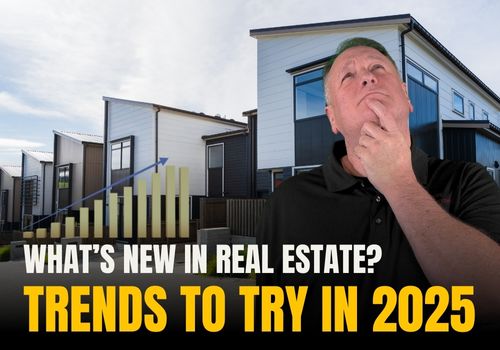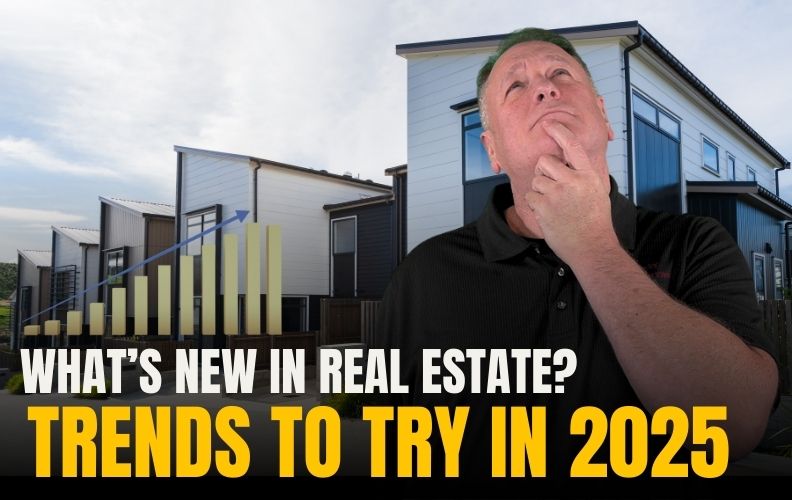What’s New in Real Estate? Trends to Try in 2025
Friday, July 11, 2025

 The real estate world is evolving fast, and 2025 promises to be a year of innovation and opportunity. With technology advancing, lifestyle priorities shifting, and sustainability coming into sharper focus, both buyers and industry professionals need to stay ahead. This guide unveils the new real estate trends and essential real estate market trends 2025 that will shape how we buy, sell, invest, and live, starting now.
The real estate world is evolving fast, and 2025 promises to be a year of innovation and opportunity. With technology advancing, lifestyle priorities shifting, and sustainability coming into sharper focus, both buyers and industry professionals need to stay ahead. This guide unveils the new real estate trends and essential real estate market trends 2025 that will shape how we buy, sell, invest, and live, starting now.
1. Hybrid & Flexible Living: Homes That Adapt
Why it matters: The pandemic permanently altered how we use home space. Now, more people are seeking living environments that can shift between work, rest, and play.
What to watch in 2025:
-
Convertible rooms: Think sliding partitions enabling transformation from home office to guest room or fitness nook.
-
Multi-generational designs: Floor plans with separate entrances or in-law suites for aging parents or adult children.
-
Properties designed with intentional zoning—clearly defined “quiet areas” and “collaborative spaces”—help foster a productive and balanced environment.
Bottom line: Buyers want homes that flex with changing roles, and flexibility could become a major selling point in the new real estate trends of 2025.
2. Sustainability Sells: Green Features as Standard
Why it matters: Climate concerns and energy prices are pushing eco-consciousness from a fringe choice to a mainstream priority.
Emerging features in 2025:
-
Net-zero-ready homes: Buildings designed to offset or eliminate their carbon footprint through efficiency and renewables.
-
Eco-smart landscaping: Water-efficient gardening, edible plants, and pollinator-friendly ecosystems.
-
Recycled and locally sourced materials: Interior finishes, insulation, and flooring made from renewable or reclaimed sources.
What it means for the market: Buyers increasingly weigh eco-credentials in their purchasing decisions. Homes with built-in sustainability often command higher value and quicker sales.
3. Tech Integration: Smart Homes Evolved
Key shift: Smart tech is moving beyond convenience to full integration into core home systems, courtesy of AI and IoT upgrades.
Top 2025 integrations:
-
AI energy optimization: Systems that learn residents’ schedules and adjust heating, cooling, and lighting accordingly.
-
Holistic wellness monitoring: Smart sensors track air quality, humidity, sleep patterns, and even circadian lighting.
-
Voice-activated daily routines: From opening blinds to managing grocery orders—homes that ‘anticipate’ needs are now within reach.
Investor alert: Properties with advanced, user-friendly tech ecosystems will stand out in the race for approachable innovation.
4. Urban to Suburban: The Rise of “Peri-Urban” Hubs
New geographic trend: As remote work persists, buyers are seeking balance—access to city amenities without downtown density.
What peripheries offer:
-
Transit-accessible communities at a lower price point.
-
Mixed-use developments featuring local shops, wellness centers, green spaces, and work-friendly cafes.
-
Smaller eco-hubs enable community connection without sacrificing personal space.
In effect, the lines between urban and rural are blurring. Locations once on the fringe are now experiencing rapid appreciation, aligned with real estate market trends for 2025.
5. Co-Living 2.0: Community with Comfort
Concept refresh: Co-living is evolving beyond shared bedrooms to emphasize autonomy and community under one roof.
Upgraded formats in 2025:
-
Private studios + shared zones: Residents have personal quarters plus access to communal kitchens, lounges, workshops, or gardens.
-
Resident-led programming: Events, skill exchanges, and social experiences driven by the community itself.
-
Flexible tenancy: Monthly plans catering to freelancing professionals and frequent travellers.
Why it works: With isolation rising, co-living offers connection, cost savings, and convenience—all appealing to urban millennials, students, and professionals.
6. Wellness-Centric Design: Healthier Homes
Health meets architecture: Post-pandemic priorities still favor homes that not only look good, but feel good, from floorplan to finishes.
Wellness-focused features to expect:
-
Designing for enhanced mood and efficiency with abundant natural light and optimized ventilation techniques.
-
Noise insulation that targets external and internal disruptions for restful sanctuaries.
-
Biophilic features such as vertical gardens, lush indoor plants, and organic materials cultivate spaces that feel restorative and connected to nature.
The seller’s edge: Homes that promote wellness are selling faster, positioning healthy design as one of the hot real estate market trends 2025.
7. Fractional & Modular Investing: Access for Everyone
Breaking barriers: With rising prices, more buyers are exploring fractional ownership and modular housing for affordability.
2025 developments:
-
Land co-ownership platforms: Neighbors share ownership of a single plot, each owning a modular unit (tiny or small home).
-
Vacation fractional models: Multiple owners share a vacation property, each taking turns using it.
-
Accessory dwelling units (ADUs): Modular in-law suites or guest cottages add flexibility and potential rental income.
Result: Investment opportunities expand, ownership diversifies, and cost sharing becomes a crucial entry strategy—one of the most exciting new real estate trends ahead.
8. AI-Powered Shopping & Sales
The real estate industry is stepping into a new era of digital transformation offering those with early insights a competitive advantage. AI-driven platforms are streamlining how buyers and sellers engage.
Platforms in 2025 will offer:
-
Smart search engines using natural language, like “three-bedroom house with plenty of natural light and a separate office.”
-
Predictive value analytics: AI forecasts resale value, neighborhood trends, and ROI scenarios.
-
Virtual staging AI: Allows instant customization of interiors in realistic detail—paint finishes, furnishings, layouts.
Agent tools: Professionals who adopt these AI assistants can respond faster, market smarter, and deliver superior data-backed guidance.
9. Emphasis on Resilience & Disaster Preparedness
New buying criteria: Climate events—wildfires, floods, hurricanes—are reshaping real estate priorities.
Resilience features are gaining traction:
-
Intrinsic design: Flood-resistant foundations, fire-resistant materials, reinforced windproof construction.
-
Emergency readiness systems: Backup power solutions, safe rooms, and water purification access.
-
Zoning & insurance advantages: Buyers caring about resilience often benefit from incentives and lower premiums.
Market shift: Safety-first design is moving from optional to indispensable, making resilient homes critical in real estate market trends 2025.
10. Green Financing & ESG Alignment
Money follows values: Buyers and developers increasingly prefer funding tied to Environmental, Social, and Governance (ESG) metrics.
Key trends:
-
Green mortgages: Loans offering lower rates for energy-efficient homes.
-
Impact investment vehicles: Investors targeting projects with measurable social/environmental benefits—think community housing, rehab projects, and sustainable developments.
-
Certified sustainable districts: Neighborhoods aligned with LEED-ND, BREEAM, or WELL standards are gaining both compliance and financing perks.
Impact: ESG alignment is no longer niche. It’s reshaping underwriting, valuation, and development priorities heading into 2025.
11. Micro-Apartments & Smart Downsizing
Small space, big innovation: Especially in dense cities, micro-living resonates with young professionals, students, and entrepreneurs.
2025 solutions include:
-
Transformable interiors: Furniture that disappears into walls—think Murphy beds, drop-down desks.
-
Shared amenity floors: Rooftop gardens, lounges, laundry rooms, enhancing compact private units.
-
Affordable city-center access: Downsizers give up sprawling homes and gain proximity to civic and cultural centers.
Smart downsizing is emerging as one of the boldest new real estate trends for 2025, granting affordability, location advantage, and modern minimalism.
12. Blockchain & Tokenized Ownership
Cutting-edge ownership: Blockchain is removing inefficiencies from title management and opening up fractional investment.
What’s happening now:
-
Secure digital titles: Immutable, transparent records minimizing fraud and paperwork hassle.
-
Tokenized properties: Buyers can purchase fractions of properties—represented as tokens—enabling high liquidity and lower entry costs.
-
Smart contracts: Automatically manage rental agreements, payment flows, and escrow disbursements.
Takeaway: While still early in adoption, tokenization points to a future where real estate becomes as fluid and accessible as trading stocks.
13. Experience-Driven Commercial Real Estate
Not just homes: Commercial real estate is evolving too, shifting from offices to experience hubs.
Key evolution areas:
-
Work/live/play campus designs: Integrated spaces supporting entrepreneurship, community events, and creativity.
-
Retail-as-entertainment: Breathe new life into retail spaces via culinary centers, experiential venues, or adaptable pop-ups.
-
Health & wellness hubs: Clinics, fitness studios, and telehealth facilities become anchor tenants.
Result: Commercial spaces that offer dynamic experiences—and tenant flexibility—dominate the commercial spectrum.
14. Demographic Tailoring: Age-Specific Communities
One size doesn’t fit all: Today’s buyers are driven by life stage, and developers are targeting accordingly.
Design styles in demand:
-
Active-adult communities: Golf course adjacency, wellness centers, mobility support.
-
Student-focused micro-units: Furnished, furnished, furnished—plus high-speed Internet and study zones.
-
Family-forward suburbs: Safe streets, walkable parks, onsite daycares, and education-friendly layouts.
Strategy: Developers focusing on niche demography—rather than trying to be everything—stand out in the burgeoning real estate market trends 2025.
15. Hyper-Local Data Analytics for Decision-Making
Decisions powered by data: AI and advanced analytics help homebuyers, investors, and developers gain granular insights down to the ZIP code level.
Applications in 2025:
-
Price heat maps:Analyze pricing trends block by block.
-
Micro-crime statistics: Buyers can check safety data within a one-block radius.
-
Walkability & commute scoring: Interactive dashboards displaying transit scores, bike-friendliness, and noise levels.
Advantage: Better data equals smarter investment and development choices, helping market players stay ahead in a competitive landscape rich with real-time signals.
How to Take Advantage of These Trends in 2025
Now that we’ve unpacked the trends, here’s a quick guide to putting them into action:
-
Stay informed on local codes and incentives. Green building credits and zoning for ADUs or mixed-use are often highly localized.
-
Partner with tech-savvy experts. Seek brokers and developers who embrace AI, blockchain, and smart-home systems.
-
Know your target. Whether you're building, renovating, or marketing, tailor your strategy to a specific demographic—families, retirees, students, or professionals.
-
Don’t ignore wellness. Healthy design goes beyond surface finishes. Consider airflow, sound, light, and access to nature from the blueprint stage.
-
Explore fractional or tokenized options. These models offer lower financial entry points and flexibility for rental or resale.
-
Aim for resilience. Especially in hazard-prone areas, invest in quality materials and resilience-first certifications.
-
Focus on financing. Green financing is evolving fast—work with lenders and investors who offer favorable terms for sustainable properties.
Why This Matters to You
For buyers: You’ll have more options and smarter homes. Whether you want flexibility, affordability, sustainability, or community, 2025’s market has something for you.
For sellers & developers: Aligning with fresh demands—wellness, tech, green building—can mean faster sales and premium pricing.
For investors: Transparent, data-driven markets and tokenization create new pathways into real estate without needing a multimillion-dollar portfolio.
In Summary
The year ahead promises transformation. New real estate trends are zeroing in on flexibility, sustainability, wellness, tech integration, and community resonance. The real estate market trends 2025 already point toward hybrid homes, AI-powered systems, niche demographics, co-living, fractional ownership, resilient design, green financing, and smart analytics.
What truly matters here isn't just visual appeal—it's about staying relevant and aligned with today’s evolving needs.. By embracing the shifts in living preferences, climate priorities, tech capabilities, and demographic behaviors, you position yourself at the forefront of market demand.
Your Next Move
-
Buyers: Create a must-have list featuring flexibility, wellness, and green elements.
-
Sellers: Invest in upgrades—smart systems, resilient materials, eco-certifications—to boost appeal.
-
Investors: Explore tokenized platforms or eco-centric developments for modern portfolio diversification.
-
Developers: Integrate demographic research, data analytics, and modular tech into blueprints—and add green financing to the mix.
Real estate is changing, and 2025 is the tipping point. Whether you’re searching for your next home, selling property, or seeking investment returns, aligning with these insights will keep you ahead of the curve. Expect smarter living, richer experiences, better value, and a market that’s shaping lifestyles, not just listings.




